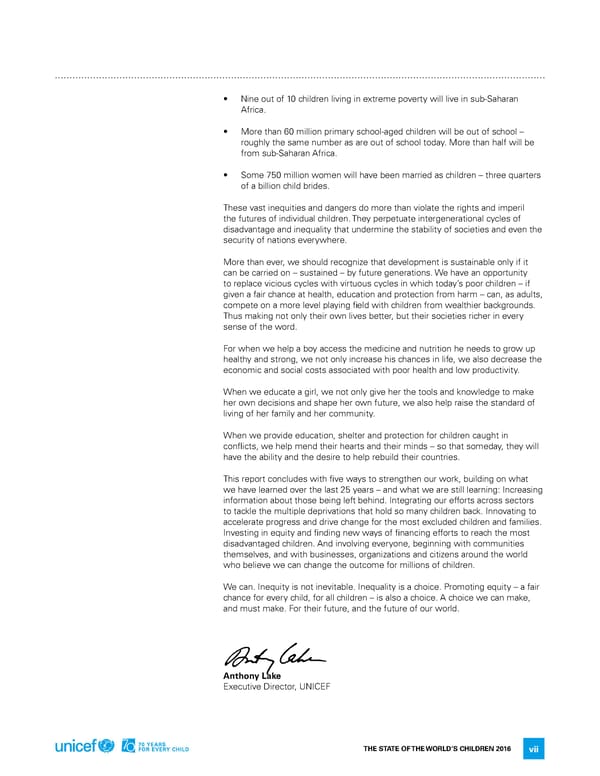• nine out of 10 children living in extreme poverty will live in sub-Saharan africa. • More than 60 million primary school-aged children will be out of school – roughly the same number as are out of school today. More than half will be from sub-Saharan africa. • Some 750 million women will have been married as children – three quarters of a billion child brides. These vast inequities and dangers do more than violate the rights and imperil the futures of individual children. They perpetuate intergenerational cycles of disadvantage and inequality that undermine the stability of societies and even the security of nations everywhere. More than ever, we should recognize that development is sustainable only if it can be carried on – sustained – by future generations. We have an opportunity to replace vicious cycles with virtuous cycles in which today’s poor children – if given a fair chance at health, education and protection from harm – can, as adults, compete on a more level playing field with children from wealthier backgrounds. Thus making not only their own lives better, but their societies richer in every sense of the word. for when we help a boy access the medicine and nutrition he needs to grow up healthy and strong, we not only increase his chances in life, we also decrease the economic and social costs associated with poor health and low productivity. When we educate a girl, we not only give her the tools and knowledge to make her own decisions and shape her own future, we also help raise the standard of living of her family and her community. When we provide education, shelter and protection for children caught in conflicts, we help mend their hearts and their minds – so that someday, they will have the ability and the desire to help rebuild their countries. This report concludes with five ways to strengthen our work, building on what we have learned over the last 25 years – and what we are still learning: increasing information about those being left behind. integrating our efforts across sectors to tackle the multiple deprivations that hold so many children back. innovating to accelerate progress and drive change for the most excluded children and families. investing in equity and finding new ways of financing efforts to reach the most disadvantaged children. and involving everyone, beginning with communities themselves, and with businesses, organizations and citizens around the world who believe we can change the outcome for millions of children. We can. inequity is not inevitable. inequality is a choice. Promoting equity – a fair chance for every child, for all children – is also a choice. a choice we can make, and must make. for their future, and the future of our world. Anthony Lake executive director, UniCef The STaTe of The World’S Children 2016 vii
 70 Years for Every Child Page 11 Page 13
70 Years for Every Child Page 11 Page 13